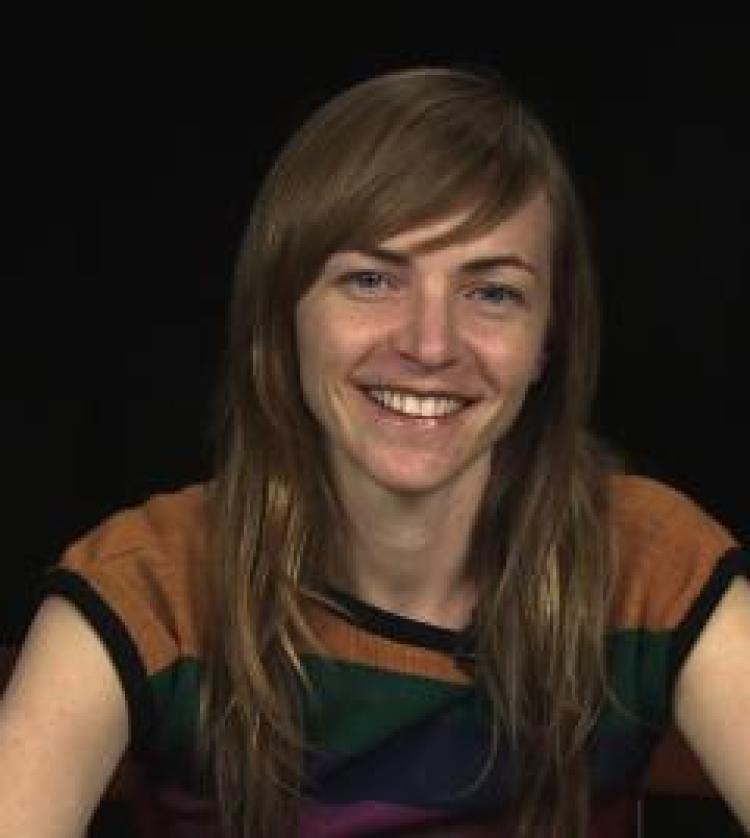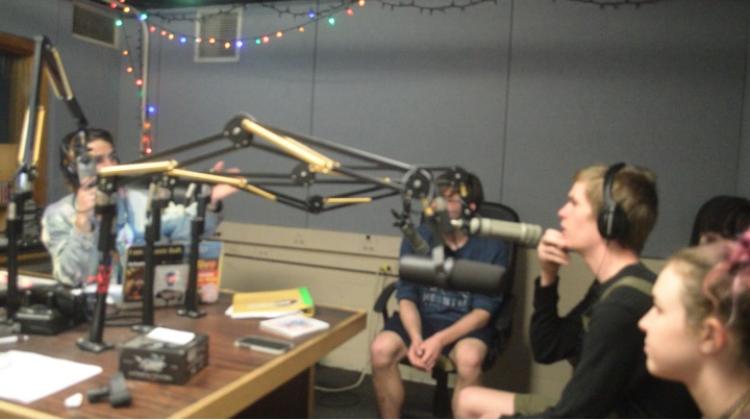By showing what they’ve learned, students learn even more
That’s one takeaway from a CU Boulder psychology course that incorporated science outreach into the curriculum
One way to learn something well is to show others what you’ve learned—in this case, with an outreach project—according to June Gruber’s students in a recent University of Colorado Boulder psychology course.
Gruber, an assistant professor of psychology and neuroscience, says the unusual approach to teaching energized students and showed the effectiveness of CU Boulder’s Making Teaching Learning and Visible Project, of which her class was a part. The project aims to share teaching portfolios to foster an exchange of ideas among instructors, who can then incorporate those ideas into their own course design.

June Gruber. At the top of the page: Andrew McGraw (film studies, '19) interviews Micah Salazar (MCDB, '18) in the lobby of the Roser ATLAS building for a class project about society's use of disparaging mental-health terms.
“What I’ll always remember is the students' engagement—it was the strongest I’ve ever seen,” Gruber said, describing the science outreach projects undertaken by students in her Human Emotion and Abnormal Psychology courses this spring.
The outreach projects were diverse and powerful, she said. One student made a film about society’s use of mental health terms; one created a “compelling and visually powerful brochure” on depression symptoms; another penned a poem about dealing with adverse emotions; and one student used their project to focus on understanding the emotional health of student athletes on the CU Boulder campus. Handbills produced in the latter project gained acclaim from students across campus, at residential halls, CU Medical Services and the athletic department.
Joseph Crispino, who graduated with a degree in psychology this spring, produced podcasts about his studies of the effect of music on human emotions. The study made him want to delve into the topic even further, for instance looking into what effect alcohol and drug use may have had on his findings.
“I had a sense that the concert experience could be very social, tribal or even therapeutic for some,” Crispino said in an email, adding:
“I wanted to see whether or not mind set and setting had an effect. Do we experience more emotion in (a concert) setting rather than listening in an isolating setting? There were too many variables at play to pinpoint one answer, but what I've determined from this project and from talking to fellow concert-goers is that people can experience profound emotions in a concert and generally feel better expressing them while others do.”
Other students captured audiences through PowerPoint presentations to local schools, letters to the editor published in local newspapers and televised interviews from local media outlets.
“This semester was one of by far the most impressive, based on the quality, the caliber and the sheer engagement of the students,” Gruber said. “They took topics they were involved with and really delved into them.”
Gruber, who came to CU Boulder from Yale University in 2014, has long been using science outreach projects to engage her students in courses. However, she believes her participation in Making Teaching and Learning Visible project, part of the university’s Faculty Teaching Excellence Program made a profound difference last spring.
Gruber, who also directs the Positive Emotion and Psychopathology Laboratory on campus, said an important step in refining her course curriculum last year was participating in monthly discussions about pedagogy with colleagues interested in new teaching methods, sharing outlines and giving the effort a focal point across the academic year.

Joseph Crispino, at microphone, records a podcast on student Radio 1190 about human emotions and music, a course project that illustrates the teaching and learning power of incorporating outreach into a curriculum. Photo originally appeared on the CU Boulder Making Teaching and Learning Visible website.
“The Faculty Teaching Excellence Program led me to evaluate my teaching effectiveness in a more systematic fashion, and maximize its ability to engage students,” Gruber said.
Students had high praise about the program in their end-of-semester ratings. The average instructor ratings for both the Human Emotion and Abnormal Psychology classes were 5.7 out of a possible 6.0 and overall course ratings were 5.6.
Gruber’s teaching portfolio program, formally called “Enhancing Student Engagement in Psychological Science through Outreach,” relied on students to pick not only the topic they were interested in communicating, but also the method of the outreach. In the end, she said, the students’ involvement in the topics they chose seemed outdistanced only by the creative methods they used to express them.
“If you give them the opportunity to be creative, they’ll do something truly exceptional,” Gruber said. “I was really left speechless by what they brought to the table. I look forward to incorporating science outreach into future psychology courses I teach.”
A portfolio of all the Making Teaching and Learning Visible programs is available on the Faculty Teaching Excellence Program website and ranges from an experiential learning program in sustainable food systems and using the art museum as a humanities classroom to an examination of the teaching methods in programing, called the Pedagogy of Code.

